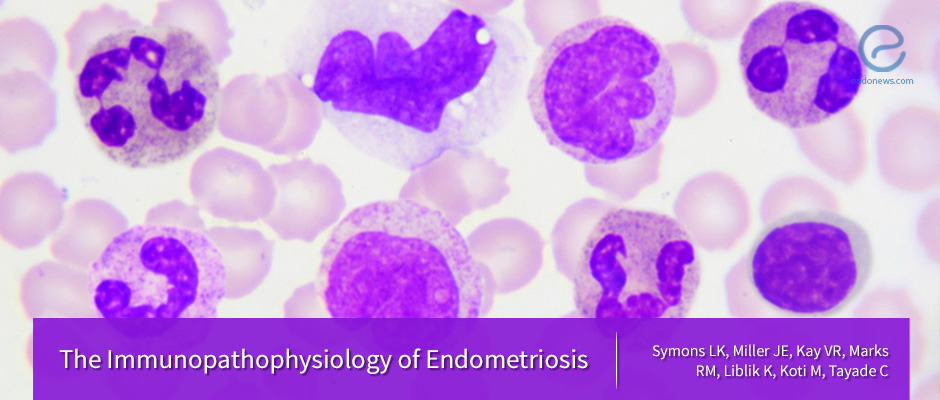Immune dysregulation in endometriosis
Jan 7, 2019
Neutrophils, macrophages, natural killer cells, and lymphocytes
Key Points
Highlight:
- This review article discusses immunological dysfunction that contributes to endometriosis.
Importance:
- The immune system has an important role in endometriosis pathophysiology, every single information may be helpful for the battle against endometriosis.
- Since immunotherapy is increasingly used for various inflammatory conditions, understanding the immune dysfunction in endometriosis may lead to the development of useful future therapy.
What's done here:
- This review provides the most recent and updated knowledge of the immunopathophysiology of endometriosis.
- The associations between the body’s immune cells and the pathogenesis of endometriosis were discussed in details, along with current challenges and future opportunities pertaining to this area of research.
Data:
- The innate and adaptive immune systems have both been implicated in endometriosis pathophysiology.
- Immune cell populations affected include neutrophils, macrophages, natural killer (NK) cells, T lymphocytes, and B lymphocytes.
- Increased neutrophil and macrophages were reported in the peritoneal fluid of endometriosis patients.
- Endometriosis peritoneal environment suppresses NK cell activity.
- The percentage of T-helper cell 17 (Th17), a subset of effector memory T cells was reported to be higher in the peritoneal fluid of women with higher stages endometriosis.
- Endometriosis was also associated with increased/activation of B cells.
Limitation:
- Most of the reported studies were only observational.
- A number of research questions remain unanswered. For example, the function of dendritic cells in endometriosis, and NK cells activating/inhibitory receptors.
Lay Summary
The connection between endometriosis and the immune system has long been proposed. However, to date, there is no real consensus on whether immune adaptations actually facilitate endometriotric lesion progression or they are a consequence of endometriosis re-occurrence. Thus, this article by Symons et al. from Department of Biomedical and Molecular Sciences, Queen’s University, Canada in Trends in Molecular Medicine aimed to research around immune dysfunction in endometriosis. The focus is on the composition and alterations of the immune system in endometriotric lesion according to the disease stages and symptoms.
Endometriotic lesions are in a complex and dynamic setting, whereby inflammatory, angiogenic, and endocrine systems exists alongside. The innate and adaptive immune systems have both been implicated in endometriosis pathophysiology. Immune cell populations affected include neutrophils, macrophages, natural killer (NK) cells, dendritic cells (DCs), T lymphocytes and B lymphocytes. Their roles, in particular, are highlighted below.
Neutrophil: Increased neutrophil was reported in the peritoneal fluid of endometriosis patients, likely due to chemo-attractants such as IL-8 that is present in endometriosis patient plasma and peritoneal fluid. Neutrophil may also be elevated due to higher estrogen level in endometriosis, which can create a pro-tumor microenvironment.
Macrophages: Elevated macrophages were observed in the peritoneal fluid and eutopic endometrium. Macrophages were shown to invade endometriotic lesions, although how they are activated and the functions of macrophage subsets of in endometriosis remain controversial.
NK Cells: Endometriosis peritoneal environment suppresses NK cell activity, thus it has been suggested that the NK cell dysfunction may contribute to immune escape of ectopic endometrial fragments. Impaired function of NK cells in endometriosis may be due to IL-6 and transforming growth factor (TGF)-b1 in the peritoneal fluid of endometriosis.
Lymphocytes: The percentage of TH17 cells was reported to be higher in the peritoneal fluid of women with stage III/IV endometriosis as compared to stage I/II. Unlike TH17, Treg levels in the peritoneal fluid/plasma did not seem to alter between late and early stage endometriosis. In addition to T cells, most studies on B cells reported their increased or activation in endometriosis.
Given these recent understanding of the immune-modulatory pathways in endometriosis, it is hoped that this knowledge will be useful for future therapeutics targeting. For example, the TH17 pathway is well recognized in chronic inflammatory conditions and has been an attractive therapeutic target. While this is an exciting possibility, a number of aspects remain important for future research. These include the recognized limitation that most of the previously reported studies were only observational, and may not identify a useful target for therapeutic development. Moreover, other open research questions are the function of DCs in endometriosis, as well as analyses of activating/inhibitory receptors on NK cells that are amenable to drug modulation.
Research Source: https://www.ncbi.nlm.nih.gov/pubmed/30054239
immune system inflammation angiogenesis endocrine endometriosis immune dysfunction immune-microenvironment inflammation

